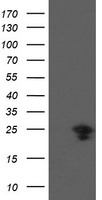PFDN3 (VBP1) (NM_003372) Human Tagged ORF Clone
CAT#: RC208482
VBP1 (Myc-DDK-tagged)-Human von Hippel-Lindau binding protein 1 (VBP1)
ORF Plasmid: tGFP
"NM_003372" in other vectors (4)
Need custom modification / cloning service?
Get a free quote
CNY 2,400.00
CNY 3,705.00
CNY 300.00
CNY 1,999.00
CNY 2,700.00
Specifications
| Product Data | |
| Type | Human Tagged ORF Clone |
| Tag | Myc-DDK |
| Synonyms | HIBBJ46; PFD3; PFDN3; VBP-1 |
| Vector | pCMV6-Entry |
| E. coli Selection | Kanamycin (25 ug/mL) |
| Mammalian Cell Selection | Neomycin |
| Sequence Data |
>RC208482 ORF sequence
Red=Cloning site Blue=ORF Green=Tags(s) TTTTGTAATACGACTCACTATAGGGCGGCCGGGAATTCGTCGACTGGATCCGGTACCGAGGAGATCTGCC GCCGCGATCGCC ATGGCGGCCGTTAAGGACAGTTGTGGCAAAGGAGAAATGGCCACAGGGAATGGGCGGCGGCTCCACCTGG GGATTCCTGAGGCCGTGTTTGTGGAAGATGTAGATTCCTTCATGAAACAGCCTGGGAATGAGACTGCAGA TACAGTATTAAAGAAGCTGGATGAACAGTACCAGAAGTATAAGTTTATGGAACTCAACCTTGCTCAAAAG AAAAGAAGGCTAAAAGGTCAGATTCCTGAAATTAAACAGACTTTGGAAATTCTAAAATACATGCAGAAGA AAAAAGAGTCCACCAACTCAATGGAGACCAGATTCTTGCTGGCAGATAACCTGTATTGCAAAGCTTCAGT TCCTCCTACCGATAAAGTGTGTCTGTGGTTGGGGGCTAATGTAATGCTTGAATATGATATTGATGAAGCT CAGGCATTGTTGGAAAAGAATTTATCGACTGCCACAAAGAATCTTGATTCCCTGGAGGAAGACCTTGACT TTCTTCGAGATCAATTTACTACCACAGAAGTCAATATGGCCAGGGTTTATAATTGGGATGTAAAAAGAAG AAACAAGGATGACTCTACCAAGAACAAAGCA ACGCGTACGCGGCCGCTCGAGCAGAAACTCATCTCAGAAGAGGATCTGGCAGCAAATGATATCCTGGATT ACAAGGATGACGACGATAAGGTTTAA >RC208482 protein sequence
Red=Cloning site Green=Tags(s) MAAVKDSCGKGEMATGNGRRLHLGIPEAVFVEDVDSFMKQPGNETADTVLKKLDEQYQKYKFMELNLAQK KRRLKGQIPEIKQTLEILKYMQKKKESTNSMETRFLLADNLYCKASVPPTDKVCLWLGANVMLEYDIDEA QALLEKNLSTATKNLDSLEEDLDFLRDQFTTTEVNMARVYNWDVKRRNKDDSTKNKA TRTRPLEQKLISEEDLAANDILDYKDDDDKV |
| Chromatograms |
CHROMATOGRAMS
 Sequencher program is needed, download here. |
| Restriction Sites |
SgfI-MluI
Cloning Scheme for this gene
Plasmid Map

|
| ACCN | NM_003372 |
| ORF Size | 591 bp |
| OTI Disclaimer | The molecular sequence of this clone aligns with the gene accession number as a point of reference only. However, individual transcript sequences of the same gene can differ through naturally occurring variations (e.g. polymorphisms), each with its own valid existence. This clone is substantially in agreement with the reference, but a complete review of all prevailing variants is recommended prior to use. More info |
| OTI Annotation | This clone was engineered to express the complete ORF with an expression tag. Expression varies depending on the nature of the gene. |
| Product Components | The ORF clone is ion-exchange column purified and shipped in a 2D barcoded Matrix tube containing 10ug of transfection-ready, dried plasmid DNA (reconstitute with 100 ul of water). |
| Reconstitution | 1. Centrifuge at 5,000xg for 5min. 2. Carefully open the tube and add 100ul of sterile water to dissolve the DNA. 3. Close the tube and incubate for 10 minutes at room temperature. 4. Briefly vortex the tube and then do a quick spin (less than 5000xg) to concentrate the liquid at the bottom. 5. Store the suspended plasmid at -20°C. The DNA is stable for at least one year from date of shipping when stored at -20°C. |
| Note | Plasmids are not sterile. For experiments where strict sterility is required, filtration with 0.22um filter is required. |
| Reference Data | |
| RefSeq | NM_003372.7 |
| RefSeq Size | 1643 bp |
| RefSeq ORF | 594 bp |
| Locus ID | 7411 |
| UniProt ID | P61758 |
| Domains | DUF232 |
| Protein Families | Druggable Genome |
| MW | 22.6 kDa |
| Gene Summary | The protein encoded by this gene interacts with the Von Hippel-Lindau protein to form an intracellular complex. The encoded protein functions as a chaperone protein, and may play a role in the transport of the Von Hippel-Lindau protein from the perinuclear granules to the nucleus or cytoplasm. Alternative splicing and the use of alternate transcription start sites results in multiple transcript variants encoding different protein isoforms. [provided by RefSeq, Jan 2015] |
Documents
| Product Manuals |
| FAQs |
| SDS |
Resources
Other Versions
| SKU | Description | Size | Price |
|---|---|---|---|
| RC208482L3 | Lenti ORF clone of Human von Hippel-Lindau binding protein 1 (VBP1), Myc-DDK-tagged |
CNY 5,890.00 |
|
| RC208482L4 | Lenti ORF clone of Human von Hippel-Lindau binding protein 1 (VBP1), mGFP tagged |
CNY 5,890.00 |
|
| RG208482 | VBP1 (tGFP-tagged) - Human von Hippel-Lindau binding protein 1 (VBP1) |
CNY 4,000.00 |
|
| SC117984 | VBP1 (untagged)-Human von Hippel-Lindau binding protein 1 (VBP1) |
CNY 2,400.00 |


 United States
United States
 Germany
Germany
 Japan
Japan
 United Kingdom
United Kingdom
 China
China





